Australian rules football in Queensland
Australian rules football in Queensland has a history which dates back to the mid-1860s.[2] By the early 1880s it was the most prominent football code in the colony, but was progressively overtaken by the Rugby code, resulting in the local game disbanding in the early 1890s. The sport was revived in the early 1900s and continued to be played throughout the twentieth century, despite the majority of the state being considered for much of the century to be well behind the Barassi Line (the notional line dividing Australia into Australian rules and Rugby 'territories').
| Australian rules football in Queensland | |
|---|---|
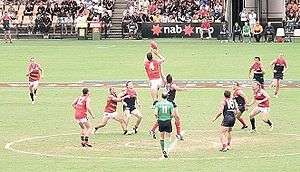 | |
| Governing body | AFL Queensland |
| First played | June 1866, Brisbane |
| Registered players | 180,132 |
Club competitions | |
Audience records | |
| Single match | 37,224 (2005). AFL Brisbane Lions vs Collingwood (Gabba, Brisbane)[1] |
Australian rules football's continued surge in popularity in south east Queensland is most likely due to the continued success of the Brisbane Lions in the national Australian Football League (AFL) competition, combined with the AFL's financial support for the local game. That support saw the introduction of a second AFL club in Queensland, the Gold Coast Suns in 2011.
In Queensland, the sport is typically referred to as "AFL", or less frequently "Australian Football", "Aussie Rules" or "Australian Rules".
History
Early Beginnings in South East Queensland
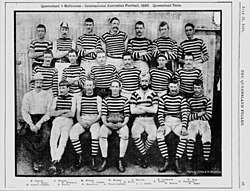
The earliest known record of Australian rules football commencing in Queensland was in May 1866, when the Brisbane Football Club was formed,[3] with the aim of keeping cricketers fit in the winter months. The club played its first match on Saturday 9 June 1866 at Queen's Park (now part of the Brisbane City Botanic Gardens).[4] By 1870 four more clubs had been created: Volunteer Artillery, Brisbane Grammar School, Civil Service and Ipswich, all adopting Victorian Rules over rugby football.
The original Brisbane Football Club disbanded in the late 1880s and has no direct relationship to the modern Brisbane Bears or Lions clubs.finite recess.
Revival
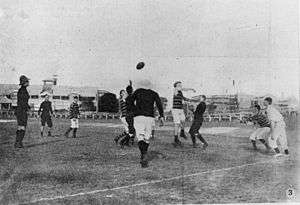

The game was revived when the Queensland Football League (QFL) was formed in July 1903. The first premiership was held in 1904 with most games being played at Queen's Park, a sporting facility within the grounds of the Brisbane Botanic Gardens.
From 1905 to 1914 games were regularly played at the Brisbane Cricket Ground.
In 1908, Queensland again sent delegates to the Australasian Football Council, this time, fielding a side in the Jubilee Australian Football Carnival which saw all Australian states as well as New Zealand compete.
In 1914 a carnival to promote the code was held in Brisbane. The participating teams were Collingwood, Perth, South Adelaide and Cananore.
Between 1915 and 1919 the competition went into recess owing to World War I. Since the inception of the QFL, more than fifty teams have played in the premiership competition.
In August 1927 at a meeting of the Australian National Football Council it was decided that each of the state leagues were to include the words 'Australian National' in their names. Accordingly, the QFL was renamed the Queensland Australian National Football League (QANFL) and football continued a steady growth in Brisbane.
1940s and 60s – The Game Expands outside South East Queensland
AFL was introduced to Far North Queensland during both World Wars. In 1913, a team of servicemen briefly existed on Thursday Island. In 1944, a league of servicemen was formed around the Atherton Tableland. Teams represented included Wongabel, Wondelca, Kairi, Mareeba and Ravenshoe.
In 1952, the Brisbane Exhibition Ground hosted a VFL match between Essendon and Geelong and was the first official VFL match to be played under floodlights.
In 1955 a league was introduced to Townsville. In 1957 land was purchased in Cairns for the first dedicated field and competition began there. A league was also introduced to Mount Isa later.
Another VFL exhibition game was played at the Brisbane Cricket Ground in 1959, attracting a large crowd.
In 1964 the QANFL became the Queensland Australian Football League (QAFL), a limited liability company.
In the early 1970s, the first leagues appeared in Mackay, the Darling Downs, Rockhampton and Bundaberg.
1980s and The Brisbane Bears
Born and bred Queenslander Jason Dunstall debuted for the Hawthorn Hawks in 1985 and quickly became one of the greatest players in the game, despite remaining almost unknown in his home state. He briefly represented a Queensland State of Origin team which played in a low key game against New South Wales in Sydney.
In 1986 it was announced that teams from Brisbane (Brisbane Bears) and Perth (West Coast Eagles) would compete in the Victorian Football League (VFL) from 1987. Much of the Bears team were South Australian players from the South Australian National Football League and Victorians from the Victorian Football League. Although the team was known as Brisbane, home games were played at Carrara Stadium on the Gold Coast, nearly 100 km from Brisbane.
The Bears were hugely unsuccessful on the field, and with the admission of the successful Brisbane Broncos rugby league team into the New South Wales Rugby League, the popularity of Australian rules football plummeted, while the successful Broncos, made up primarily of local talent, thrived. The NSWRL had resisted the move for a team in Queensland for years but created the Broncos and the Gold Coast-Tweed Giants the very next season.
The admission of the Bears had a deleterious effect on the QAFL which weakened over the following years.
During this era, few local players, besides Jason Dunstall, were produced with the exception of Gavin Crosisca and Marcus Ashcroft who were successful at VFL level.
Demographic trends saw Victorian and South Australians (states where the code is extremely popular) migrating interstate in large numbers to Queensland. Support for Australian rules football grew, despite a lack of success from the Bears and support from fans. 1990 saw the Brisbane Bears receive their first Wooden Spoon, which saw new coach Queensland-born Norm Dare sacked at the end of the season.
1991 was a mixed year for the Brisbane Bears. At the end of the home and away season, the Bears' Seniors team would receive the Wooden Spoon again while the Bears' Reserves team finished in 3rd position. They qualified for the Reserves Grand Final, where they scored a 34-point victory over the Melbourne Demons to become the first team from outside Victoria to win an AFL premiership.
1992 saw the debut for the Brisbane Bears of the most significant locally produced young talent to emerge from the state – Michael Voss. Although born in country Victoria, Voss spent most of his childhood in Queensland and represented the state at junior level where he shone, before going on to captaining the Brisbane Lions and becoming one of the all-time greats of the game. Voss was followed by a small number of players from Queensland to find their way into the newly named Australian Football League (AFL).
In 1993, the Brisbane Bears moved from the Gold Coast, to the Brisbane Cricket Ground in the inner-Brisbane suburb of Woolloongabba. Interest, crowds and membership in the team increased considerably. Games between the Bears and popular Victorian sides Collingwood, Essendon and Hawthorn drew particular interest.
In 1995, the Bears made the AFL finals for the first time.
In 1996, six sell-out games at the Gabba caused the State Government to consider funding re-development of the ground, something that would be done several times over the following years to transform the small stadium into a world class venue.
After the 1996 season, the QAFL, having weakened significantly with the introduction of the Bears, finally went into receivership. A new governing body, the Queensland Australian Football Council, was formed in 1997, alongside a new premiership competition, Queensland State Football League (QSFL).
Boom Times – Brisbane Lions Era
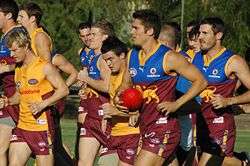
The Brisbane Lions began in 1996, when the AFL approved a merger between the Brisbane Bears and the formerly Melbourne based Fitzroy Football Club and on-field success increased substantially with the injection of Fitzroy players, further boosting the popularity of the code.
In a breakthrough for Australian Football in late 1990s, GPS schools in South East Queensland began playing Australian Rules for the first time since the turn of the century. Previously to this, South East Queensland private schools had been a staunchly rugby union stronghold and many schools did not allow Australian Football to be played as it would compete with rugby for players. The Jason Dunstall Cup (named after champion Queensland product Jason Dunstall) was later begun, with independent schools such as BBC, ACGS and Nudgee College, represented with teams in the first division of the Queensland Independent Schools Australian Football League (QISAFL). However interest soon waned and the trophy holds very little interest to the schools.
Also in the 1990s, the Cairns league experienced enormous growth financially on the back of gaming, with the Cazaly's social club quickly becoming the largest sporting club north of Brisbane. The Cazaly's Stadium received lights to play popular night football games and the western stand from the Gabba was transplanted to Cazaly's Stadium, enabling it to host AFL matches.
In 1999, the QSFL also went into voluntary liquidation, being replaced by a new organisation, AFL Queensland (AFLQ) in 2000. The new premiership competition was called the AFLQ State League. That year, Nick Riewoldt became the first Queensland produced player to be taken as number 1 pick in the AFL Draft, recognised as the best junior talent in the nation.
In 2001, a Women's Footy competition began in earnest.
Three successive premierships for the Brisbane Lions in 2001, 2002 and 2003 saw crowds to Australian Football League matches in Brisbane to grow to an average of over 30,000, and in terms of attendance and membership, the AFL team in 2003 was the most popular team of any football code in the state. However, despite increasing television ratings and media exposure, Australian rules football remains overall less popular than rugby league and rugby union in the state.
During the Lions premiership years, junior Aussie Rules numbers exploded in South East Queensland, and grew solidly right across the state.
Recent history
From 2005, the growing local State League expanded to two divisions.
A record number of 13 Queenslanders were invited to attend the 2006 AFL Draft camp, representing 18% of the 72 camp invitees.[5]
Although state league crowds have dwindled with the increase in support for the Brisbane Lions AFL team, a healthy crowd of 3,257 saw the Southport Sharks defeat Morningside in the 2005 AFLQ Grand Final at the Gabba, while a crowd of over 3,000 saw the Southport Sharks win back-to-back premierships in 2006 at Carrara.
In 2006, support for the Brisbane Lions waned substantially due to two successive seasons out of the finals. From 2005 to 2006 total memberships decreased from 30,027 to 26,429 and the average home crowd fell from 33,101 to 28,305.
The impact of the Brisbane Lions fall from grace was felt at grassroots level by the sport in Brisbane. From 2006, the much celebrated Jason Dunstall Cup was no longer contested by its former powerhouse schools – ACGS or BBC. Most other major private schools ceased playing the sport at the top level. Despite the decline of school competitions, local junior club numbers continued to grow.
Nevertheless, Queensland performed extremely well in the 2006 AFL Draft with a record 11 recruits, including 8 of the first 32 picks. Surprisingly, the majority of the movement was in the regional areas, with some picks from previously undrafted regional areas such as Townsville, Toowoomba and Mackay providing AFL talent.[6][7]
AFL on the Gold Coast
The Gold Coast, where a hole had been left once the Brisbane Bears moved away, had grown to become the 6th biggest urban area with nearly half a million people, many of which had migrated from states where Australian Rules is popular. In recent years, several bids were made for a new AFL franchise by the powerhouse Southport Sharks Australian Football Club, including attempts to lure a Melbourne-based club in 2004.[8] Many of these attempts were knocked back due to the city's many failed sporting franchises. However demographic trends suggested a growing demand for Australian rules football and in 2005 a pre-season practice match between the Brisbane Lions and Essendon drew a healthy audience of 16,591. Following the match, the Australian Football League stepped up efforts to expand into the Gold Coast market. A series of pre-season games and a home and away match was scheduled at Carrara for 2006. In response, the rival NRL competition admitted a Gold Coast Titans franchise. Despite an average crowd of around 10,000 (comparatively low by AFL standards), the AFL officially announced a strategy to include a Gold Coast side in the next 5 years.[9] A bitter turf war with the National Rugby League resulted over the use of Carrara stadium.[10] In the same year, AFL CEO Andrew Demetriou was quoted to declare that the league would compete directly with the NRL for marketshare in Queensland.
In July 2006, with the backing of the local government and the AFL, the Kangaroos did a deal which saw them move their home games scheduled at Manuka Oval in Canberra to play a number of home games at Carrara Stadium on the Gold Coast in 2007.[11] The AFL began a heavily subsidised grassroots participation program and pushed for the number of AFL games, including pre-season matches to steadily increase to ready the region for its own side. Relocation of the Kangaroos was seen by many to be the safest option for the AFL, and an existing Queensland Government deal prevented use of the Brisbane Cricket Ground for a second Queensland side until 2010. The AFL's plans were further complicated by growing competition in the market. The entry of several licences from other sports into the market as well as the proposed expansion of A-League put additional pressure on the league to fast-track the relocation of the Kangaroos.
In December 2007, after two years of resisting the AFL's push for their relocation, the Kangaroos finally officially rejected the AFL's $100 million proposal.[12] This was despite threats from the league to pull financial assistance from the club and cancel the Gold Coast home game agreement if they don't move. The failure of the AFL to secure a stadium deal for Carrara with the Queensland Government was seen as one of the deciding factors. A consortium was selected by the AFL in early 2008 and the GC17 set out to make an official bid for the licence with criteria defined by the league. The Queensland government finally committed to funding for a stadium in early 2009 after which the AFL was granted a provisional licence pending further federal government funding. In 2010 The Gold Coast Suns were created and entered a team in the NEAFL. In 2011 they made their debut playing in the AFL and vindicated the investment in creating the new AFL side by outdrawing the rival codes.
The Gold Coast Suns
The Gold Coast Suns took to the AFL field in 2011 and when they were joined by a second new AFL team, The Greater Western Sydney Giants the extra game created per round led to a huge increase in television and media rights over the previous deal. This huge increase in revenue is seen as repaying the initial investment costs of the two new teams.
The 2015 AFL season is the Gold Coast Football Club's third season in the Australian Football League (AFL). The Gold Coast Football Club's reserves team also competed in the NEAFL. The club will again be captained by Gary Ablett, Jr. and will be coached by Rodney Eade.[13]
Leagues
Since 2011 Queensland based teams have competed in the northern division of the North East Australian Football League (NEAFL, also contested by teams from New South Wales, Northern Territory and Australian Capital Territory).
This competition became the first division in the region, while Queensland Australian Football League (former "AFLQ State League", first started in 1903) became the 2nd division.
Men's leagues
|
Junior leagues
|
Women's leagues
|
|
Clubs
There are two fully professional football clubs in Queensland, the Brisbane Lions and the Gold Coast Suns who both play in the main national league, the Australian Football League (AFL). They also play (with reserve teams) in the interstate competition North East Australian Football League. Other teams from the region that take part of it are Aspley, Redland and Southport.
The main competition of Queensland, Queensland Australian Football League, has 9 teams participating of it.
Representative Side
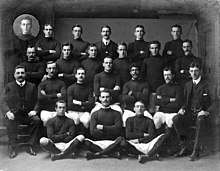
The Queensland state team, known as the "Maroons" has played interstate representative matches against all other Australian states, as well as selecting State of Origin teams as both Queensland and later as part of a combined "Australian Alliance" side.
In inter-league matches since 1991, Queensland has defeated both Tasmania and the Australian Capital Territory, and has performed well against more accomplished states such as Western Australia without winning.
The Queensland under-18 representative side is known as the Scorpions.
Also there are representative sides for areas within Queensland used during inter-league matches with-in Queensland itself. They include:
- Bushrangers – representing the entire South East Queensland region Official Site
- Gold Coast Stingrays – representing the Gold Coast region
- Suncoast Power – representing the Sunshine Coast region Official Site
- Western Taipans – representing the western regions, including the cities of Ipswich and Toowoomba. Official Site
- Northern Raiders – representing the Northern Suburbs of Brisbane and Bribie Island. Official Site
Principal Venues
- 1866 – ca 1890: Queen's Park (now part of the Brisbane City Botanic Gardens); the original Cricket Ground at the 'Green Hills' (now Petrie Terrace)
- 1904 – 1912: Queen's Park
- 1905 – 1914: Brisbane Cricket Ground, Exhibition Ground
- 1920 – 1950s: Perry Park, Exhibition Ground for some games, including the 1950 interstate carnival
- 1959 – 1971: Brisbane Cricket Ground
- 1970s – 1980s: Windsor Park
- 1998 – 2004: Giffin Park
- 2005–present: Brisbane Cricket Ground, Carrara Stadium, Cazaly's Stadium
| Brisbane | Gold Coast | Cairns |
|---|---|---|
| Brisbane Cricket Ground | Carrara Stadium | Cazaly's Stadium |
| Capacity: 42,000 | Capacity: 25,000 | Capacity: 13,500 |
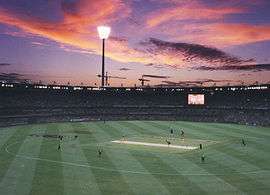 |
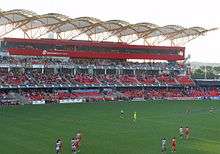 |
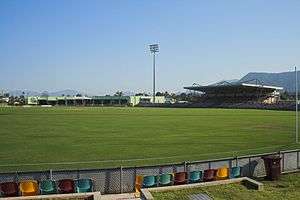 |
Audience
Attendance record
- 37,224 (2005). AFL Brisbane Lions vs Collingwood (Gabba, Brisbane)
Major Australian Rules Events in Queensland
- Australian Football League Premiership Season (Brisbane Lions and Gold Coast Suns home games)
- Queensland Australian Football League Grand Final
Players
Participation
In 2007, there were around 3,300 senior players in Queensland, and in 2009 there were a total of 103,358 participants.[14] Although the overall participation per capita is around 2%, the sport is growing faster in Queensland than any other Australian state.[15]
Great Queensland players
Over the years, Queensland has produced an array of talent for elite leagues such as the Australian Football League, such as Jason Dunstall, Marcus Ashcroft, Gavin Crosisca, Scott McIvor, Danny Dickfos, Che Cockatoo-Collins, Steven Lawrence, Clark Keating, Trent Knobel, Clint Bizzell, Brett Backwell, Brett Voss, Michael Voss, Mal Michael and Robert Copeland.
Notable Queensland players in the VFL/AFL
| Player | QLD junior/senior club | VFL/AFL Debut | VFL/AFL Games | VFL/AFL (Goals) | Connections to Queensland, Notes & References |
|---|---|---|---|---|---|
| Jason Akermanis | Mayne | 1996 | 325 | 421 | Brisbane Raised. Represented the "Australian Football Alliance" in State of Origin. Brownlow medallist. QLD Team of the Century member |
| David Armitage | Morningside | 2007 | 150 | 89 | |
| Marcus Ashcroft | Southport | 1989 | 318 | 145 | Gold Coast born and raised. First Queenslander to play 300 AFL games. Triple premiership Brisbane Lions player. QLD Team of the Century member. |
| Claye Beams | Labrador | 2011 | 30 | 21 | Gold CoastRaised. |
| Dayne Beams | Southport | 2009 | 112 | 118 | Gold Coast Raised. 2010 Collingwood Premiership player. 2012 All Australian team. |
| Clint Bizzell | Wilston Grange | 1996 | 163 | 79 | Brisbane born and raised |
| Simon Black | 1998 | 320 | 170 | Mount Isa born. Brownlow medallist | |
| Jamie Charman | Sandgate Hawks | 2001 | 129 | 55 | Maryborough born. Represented AFL Dream Team in 2008 |
| Che Cockatoo-Collins | Cairns Cobras | 1994 | 160 | 215 | Born in Brisbane, raised in Cairns |
| Robert Copeland | Northern Eagles | 2001 | 143 | 39 | |
| Gavin Crosisca | Western Districts AFC | 1987 | 246 | 64 | Brisbane born and raised. Represented Queensland in State of Origin. QLD Team of the Century member |
| Courtenay Dempsey | Morningside | 2006 | 133 | 35 | |
| Charlie Dixon | Redland | 2011 | 49 | 53 | Raised in Cairns. |
| Josh Drummond | Northern Eagles | 2005 | 94 | 35 | |
| Jason Dunstall | Coorparoo | 1985 | 269 | 1254 | Brisbane born and raised. Represented Queensland four times in State of Origin and also the Allies. Australian Football Hall of famer. QLD Team of the Century member |
| Mitch Hahn | Zillmere | 2000 | 181 | 164 | Queensland born and raised |
| David Hale | Broadbeach | 2003 | 237 | 217 | Gold Coast Raised, triple Hawthorn premiership player |
| Jarrod Harbrow | 2007 | 120 | 34 | Cairns born | |
| Scott Harding | Morningside | 2006 | 50 | 15 | Queensland born |
| Rhan Hooper | Ipswich Eagles | 2006 | 54 | 56 | Charleville, Queensland born |
| Ben Hudson | University of Queensland Australian Football Club | 2004 | 168 | 19 | Brisbane Raised |
| Joel Macdonald | Mt Gravatt | 2004 | 124 | 6 | |
| Luke McGuane | Broadbeach | 2005 | 93 | 19 | Queensland born, Gold Coast raised |
| Dean McRae | Sandgate | 1987 | 141 | 55 | |
| Scott McIvor | Wilston Grange | 1985 | 200 | 96 | Queensland born and raised. QLD Team of the Century member |
| Daniel Merrett | Southport | 2005 | 145 | 45 | Gold Coast Raised |
| Mal Michael | Morningside | 1997 | 238 | 33 | Brisbane Raised. QLD Team of the Century member |
| Brad Miller | Mt Gravatt | 2002 | 157 | 120 | Brisbane born |
| Tim Notting | 1998 | 208 | 138 | Cairns born | |
| Daniel Pratt | Northern Eagles | 2004 | 119 | 10 | |
| Andrew Raines | Southport | 2004 | 111 | 12 | Gold Coast born and raised |
| Nick Riewoldt | Southport | 2001 | 319 | 689 | Gold Coast Raised |
| Zac Smith | Zillmere | 2011 | 44 | 27 | Biloela born |
| Cheynee Stiller | Northern Eagles | 2006 | 100 | 21 | |
| Kurt Tippett | Southport | 2007 | 111 | 209 | Gold Coast Raised |
| Joel Tippett | Southport | 2007 | 8 | 0 | Gold Coast Raised |
| Brett Voss | Morningside | 1997 | 170 | 67 | Queensland born and raised |
| Michael Voss | Morningside | 1992 | 289 | 245 | Brisbane Raised. Brownlow Medallist and Australian Football Hall of Famer. QLD Team of the Century member. Triple premiership captain of Brisbane Lions. |
| Jesse White | Southport | 2008 | 91 | 97 | Gold Coast Raised. |
| Brendan Whitecross | Zillmere | 2009 | 97 | 38 | Brisbane born |
| Dayne Zorko | Broadbeach | 2012 | 61 | 61 | Gold Coast Raised. Lions Pre-Season Premiership player |
| Adam Oxley | Redland | 2013 | 4 | 0 | Brisbane Raised. |
| Alex Sexton | Redland | 2013 | 26 | 11 | Brisbane Raised. |
| Andrew Boston | Palm Beach | 2013 | 8 | 7 | Gold Coast Raised. |
| Rory Thompson | Southport | 2011 | 55 | 7 | Gold Coast Raised. |
- Currently listed players are highlighted in bold
Bibliography
- John Morton's Queensland Australian Rules Year Book 1960 by John Morton, 1960
- Queensland Team of the Century Football Record Official Programme, AFL Queensland, 2003
- Official Souvenir Programme of Collingwood v South Melbourne, Queensland Australian National Football League, 1935
See also
- AFL Queensland
- Australian rules football in South East Queensland
- List of Australian Football Leagues in Queensland
- Brisbane Australian Football Club
- 1961 Brisbane Carnival
References
- Brisbane vs Collingwood, match details
- Club creations dates
- Brisbane Courier 25 May 1866
- Brisbane Courier 16 June 1866
- Dale, Mitchell (17 August 2006). "Talented trio in scout sights". Archived from the original on 20 August 2006.
- Wealth of Maroon Talent article from the Courier Mail
- Queensland dominates Draft – record 11 players chosen
- Demons' Gold Coast link prods league to act from the Sydney Morning Herald
- "AFL News, Scores, Stats, Transfers | Real Footy". Realfooty.theage.com.au. 24 March 2012.
- "NRL complains of Carrara turf war" theage.com.au 7 August 2006 URL accessed 7 September 2006
- Canberra fans get a free kick in the guts after AFL drops the ball Archived 7 January 2007 at Archive.today from the Canberra Times
- Kangaroos say no to Gold Coast couriermail.com.au
- Wilson, Terry (23 October 2012). "Ablett drops in to sweat it out with boys".
- "AFL continues to shine in sunny state". 28 October 2009. Archived from the original on 23 February 2012.
- "www.afl.com.au/cp2/c2/webi/article/205058bu.pdf" (PDF). Retrieved 18 May 2006.
External links
- Queensland Team of the Century (from Full Points Footy)
- QAFF – Queensland footy history group
| Wikimedia Commons has media related to Australian rules football in Queensland. |